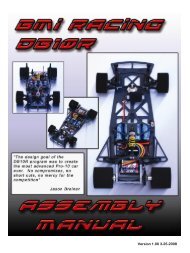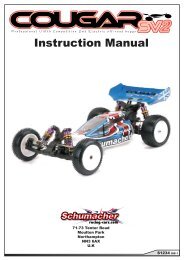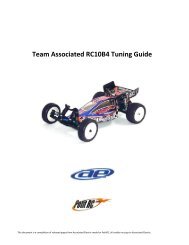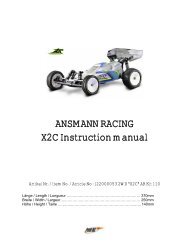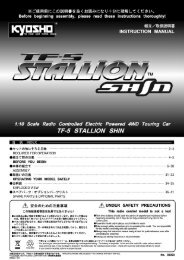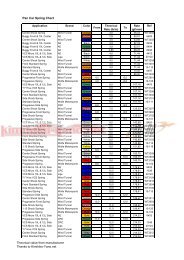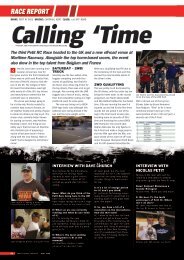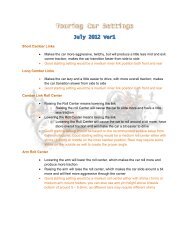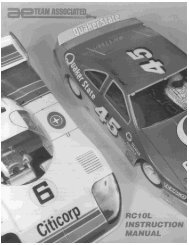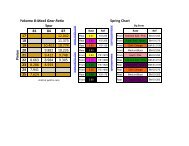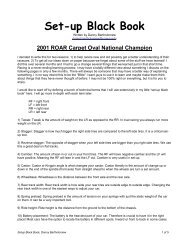Brian Kinwald XXX BK2 - Team Losi Racing
Brian Kinwald XXX BK2 - Team Losi Racing
Brian Kinwald XXX BK2 - Team Losi Racing
Create successful ePaper yourself
Turn your PDF publications into a flip-book with our unique Google optimized e-Paper software.
Adjusting the Slipper should be done after the diff is properly adjusted. If you have just finished adjusting the differential, loosen<br />
the slipper adjustment nut four full turns (e.g., 360 degrees x 4) to return the adjustment to the setting originally described in the<br />
assembly instructions. To make the final adjustments, place your car on the racing surface and give the car full throttle. The slipper<br />
should slip for one or two feet. If the slipper slips for more than two feet, you’ll need to tighten the adjustment nut. If the slipper<br />
doesn’t slip for at least one foot, back off the adjustment nut 1/8 of a turn and retry. If you can’t hear the slipper when you punch<br />
the throttle, hold the front of the car with the rear wheels still on the track and give the car full throttle. The car should push against<br />
your hand with reasonable force and the slipper only slipping slightly. Don't expect the slipper to make up for poor driving or setup.<br />
You still have to use the throttle and maintain the shocks and chassis. The slipper will help you drive more comfortably and help<br />
accelerate of corners and land jumps.<br />
The Most Sensitive Adjustments, and the most used by the <strong>Team</strong> <strong>Losi</strong> race team, are the number of washers under the front<br />
camber link ball studs and the anti-squat. See these two sections and try to familiarize yourself with the way that these adjustments<br />
affect the handling of the <strong>XXX</strong>-<strong>BK2</strong>.<br />
Ride Height is an adjustment that affects the way your car jumps, turns, and goes through bumps. To check the ride height, drop<br />
one end (front or rear) of the car from about a 5-6 inch height onto a flat surface. Once the car settles in to a position, check the<br />
height of that end of the car in relationship to the surface. To raise the ride height, lower the shock adjuster nuts on the shocks<br />
evenly on the end (front or rear) of the car you are working on. To lower the ride height, raise the shock adjuster nuts. Both left<br />
and right nuts should be adjusted evenly.<br />
You should start with the rear ride height where the car comes to a rest at a height where the dogbones are slightly below level<br />
with the surface. The front ride height should be set so that the bottom of the chassis is level with the surface. Occasionally, you<br />
may want to raise the front ride height to get a little quicker steering reaction, but be careful as this can also make the car flip over<br />
more easily.Every driver likes a little different feel so you should try small ride height adjustments to obtain the feel you like. We<br />
have found that ride height is really a minor adjustment. This should be one of the last adjustments after everything else has been<br />
dialed in. Do not use ride height adjustment as a substitute for a spring rate. If your car needs a softer or firmer spring, change the<br />
spring. Do not think that simply moving the shock nuts will change the stiffness of the spring; it will not!<br />
Rear Hub Camber Location is best set according the settings described in this manual. You should start with the inner hole in<br />
the top of the hub (hole "A"). The outer hole will tend to make the car feel a bit stiffer. This results in the car accelerating straighter<br />
and also makes it a bit eassier to line up for jumps. Moving to the inner hole will typically make the car go through bumps better.<br />
The inner hole may also give the feeling of more steering. This steering generally comes from the rear end though. What this<br />
means is that the rear end of the car may swing a bit more — at times even sliding more.<br />
Rear Camber Link Length can be another useful adjustment. It is virtually impossible to make a blanket statement for exactly<br />
how the length of the camber link will affect the handling under all conditions. The following is our experience with how the length<br />
of the camber link will typically affect the handling of the <strong>XXX</strong>-<strong>BK2</strong>. A longer rear camber link will usually result in more rear<br />
traction. With a longer link, the car can start to drive more square, or point-to-point. This can make it difficult to carve corners at<br />
high speed. A shorter rear camber link will generally result in more steering from the rear of the car due to increased chassis roll.<br />
This can make it easier to change directions quicker, but can cause the rear of the car to roll around if the link is too short. A<br />
shorter rear link will usually go through bumps a bit better than a long link as well.<br />
Front Carrier Camber Location is another adjustment that is almost always run in the standard (outer) location. This location<br />
keeps the car flatter with less roll. The outer location also helps the car stay tighter in turns with a more precise steering feel.<br />
Moving the link to the inner hole will make the steering react slightly slower. The advantage to the inner hole is that it can increase<br />
on-power steering and help the car get through bumps better.<br />
Washers Under the Front Camber Link Ball Stud can be added or removed. This is one of the most important adjustments<br />
on the <strong>XXX</strong>-<strong>BK2</strong> car. You should get a feel for how the number of washers affects the handling. Adding washers will make the car<br />
more stable and keep the front end flatter. Removing washers will make the steering more aggressive. This can be good in some<br />
conditions, but can also make the car difficult to drive in others. The best all-around adjustment is with one washer as per the<br />
assembly instructions.<br />
Front Camber Link Length is another adjustment that is difficult to make a generic statement for as it can have slightly<br />
different results on various conditions. The following is a summary of how this adjustment will usually impact the handling of the<br />
32



